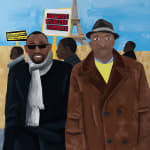-
Soimadou Ibrahim France, 1989
Les Misérables, 2022Acrylic on canvas230 x 160 cm
90 x 63 in© Soimadou IbrahimFurther images
German sociologist, George Simmel, has reflected a great deal on the question of the “foreigner” in western societies. For him, they are both remote and close to the population in...German sociologist, George Simmel, has reflected a great deal on the question of the “foreigner” in western societies. For him, they are both remote and close to the population in which they settle. This observation applies perfectly to the issue faced by the street vendors at the forecourt of the Eiffel Tower. In fact, the majority of them are migrants, most of them undocumented from former French colonies in Africa such as Senegal, Mali, Benin, and Gabon. It is therefore a paradoxical situation - they show themselves in order to sell their products but hide themselves from the eyes of the police, because the selling of their objects is considered illicit.
On one side of the room sits the installation with a variety of Eiffel Tower figurines and key chains laid out on the floor in the same way the street vendors would present their products. On the other side of the room hangs the artwork that shows people demonstrating for undocumented people’s rights on the Eiffel Tower’s forecourt. This work embodies the power and status that the Eiffel Tower represents for France; however, the power dynamic has shifted so that the demonstrators are empowered and become the voice and faces for those who’re undocumented.
In reality, undocumented people play a key role in the French economy. They occupy the jobs that French people are no longer willing to do either because they are too manual, involve night-shifts and are poorly paid, but still very important jobs for the functioning of the economy such as bin men and cleaners.
Subscribe Newsletter
Be the first to know about new exhibitions, artist updates, as well as books and more. Sign up for our newsletter below.









